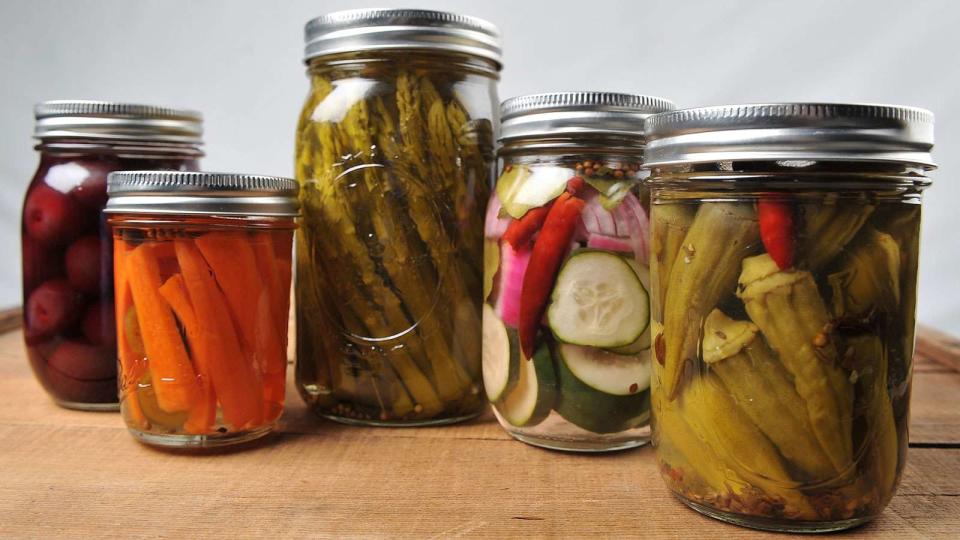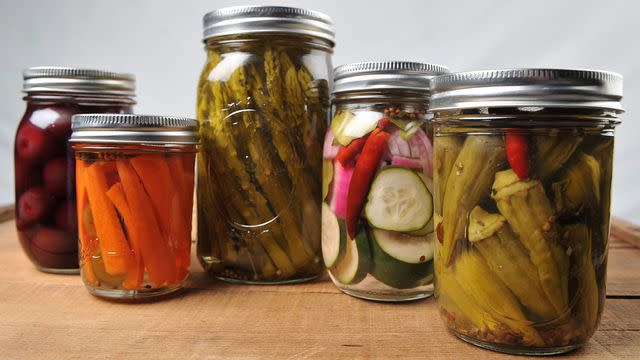It's Time to Start Pickling at Home

Pickle vegetables and fruit when they are in season, and enjoy them all year round.

Whether you are a successful gardener, an overly ambitious farmers market shopper, or simply someone who loves a little tangy zing on their tacos, burgers, barbecue, grain bowls, sandwiches, and salads, you need pickles in your pantry and refrigerator. The good news is that pickles are simple to make at home — it's easier than you think to add a tart pop of flavor to your cooking. Here's how to start pickling at home.

Pickling is fast and easy
Before you worry about canning procedures and brine ratios, start with the simplest pickles, which require just a few minutes of your time before they spend some quality time in the refrigerator to finish pickling. At their most basic level, pickles are a vegetable or fruit marinated in a brine, which is a mixture of salt, sugar, vinegar and water.
Related: You Should Quick-Pickle Your Vegetables
Onions are a great place to start. Make these Pickled Onions, stash them in the refrigerator, and then use them on this Citrus and Avocado Salad with Pickled Onions, Shrimp Fried Rice with Coconut and Pickled Onions, Frito Pie, this Roasted Hot Honey Sweet Potato Salad, or any other salads, grain bowls, sandwiches, tacos, burritos, or another savory dish that could use a bit of zing. Once you've pickled onions, be sure to make Pickled Shallots and Quick Pickled Pearl Onions for dishes and cocktails. Pickled onions will last a week or more in the refrigerator.
The same process works for other refrigerator pickles, like Bobby Flay's Dill Pickles, these Danmuji (Pickled Daikon), Snack Peppers, Pickled Beets and Eggs, Zucchini Pickles, Pickled Peaches, and Lemon Okra Pickles. They call for a few hours, days, or weeks in the refrigerator for the best flavor, but require no extra hands-on time.
Pickles are easy to customize
Once you've made pickles a few times, you'll see how easy they are, and how you can customize the flavors with just a few ingredient swaps. Feel free to play around with the spices used in the brine for your pickles. You can swap in equal amounts of nigella seeds, cumin seeds, coriander seeds, or different types of peppercorns in your brine. And you can vary the vinegar used for the brine as well. Pick any kind of vinegar to make these pickled onions — red wine vinegar, apple cider vinegar, white wine vinegar, or rice vinegar.
Making pickles helps you reduce food waste
If you have too much produce on hand, pickles are the answer. Make pickles in summer, and reap the benefits every time you open your refrigerator and pantry all year round. Making pickles is also a good way to use up half-empty bottles of vinegar you have in your kitchen; just mix and match vinegars to make your brine, using half rice vinegar and half apple cider vinegar, for example. You can also use up any spices that are getting old. Simply add them to your pickling brine to experiment with different flavor combinations.
When you've eaten the pickles, the pickling brine can be reheated and reused one more time to make a new batch of onions. Or, you can put it to use in other recipes, mixing it into marinades, salad dressings, sauces, or soups to add a hit of bright acidity.
Related: 10 Essential Tools for Quick Pickling Vegetables
Pickles can feed you all year round
Yes, you can get most produce year-round, but pickling is a great way to enjoy the favors of spring and summer anytime, even if you haven't seen fresh corn in months. Follow these instructions to process and can pickles so they are shelf-stable, and store them in a cool, dark place so you can enjoy pickled cucumbers, corn, peppers, onions, and garlic in the middle of winter.
For more Food & Wine news, make sure to sign up for our newsletter!
Read the original article on Food & Wine.